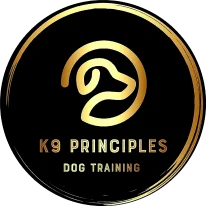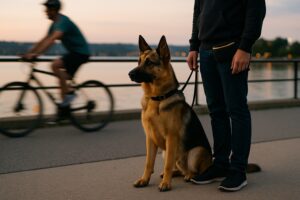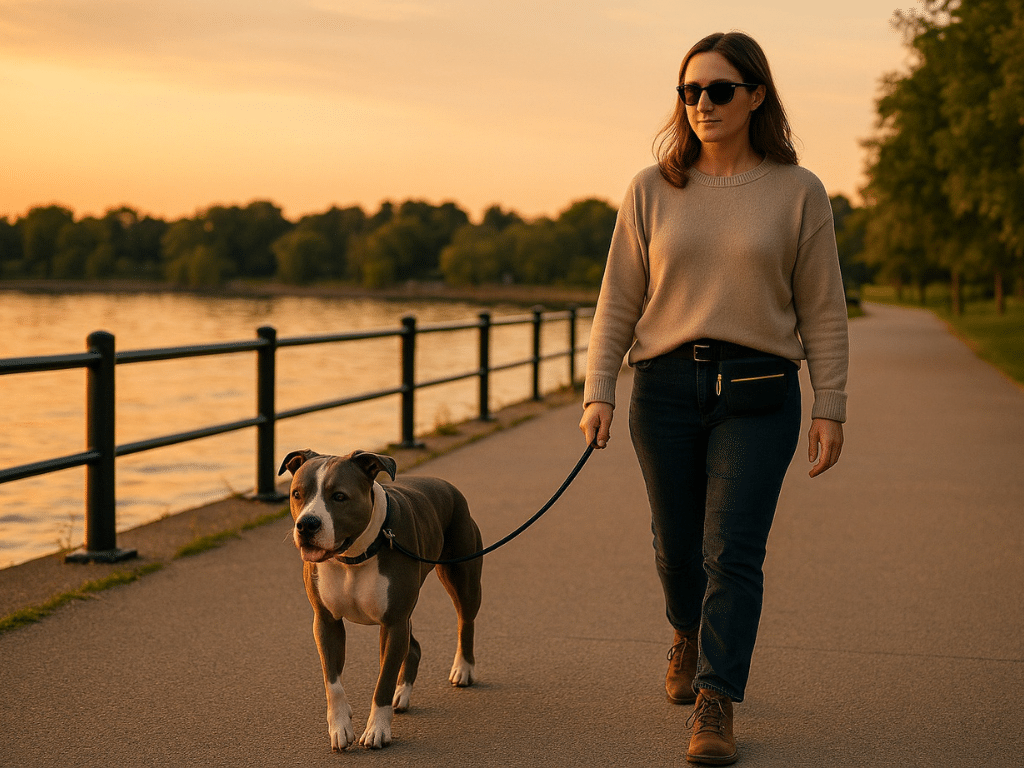Every successful plan in dog training in Hamilton starts with one truth: exercise sets the brain state that makes learning possible. The right movement at the right intensity turns scattered energy into focus, softens impulsive choices, and speeds up how quickly a dog understands each cue. The wrong kind of exercise—too frantic, too long, or poorly timed—does the opposite, fuelling distraction and eroding self-control. K9 Principles builds programs around this state-first approach because families deserve training that feels easier from the very first week. Balanced exercise is not about running a dog to the point of collapse. It is about using movement deliberately to land in the teachable zone where the dog can listen, think, and respond. That is the moment where a recall feels crisp, a loose lead stays loose, and a stay remains steady while the world strolls past. For households beginning dog training, this is the clearest path to progress. For locals seeking Hamilton dog training, it is the difference between battling chaos on Bayfront Park paths and enjoying calm, connected walks that fit real life.
The Science Made Simple: Arousal, Focus, and the Learning Window
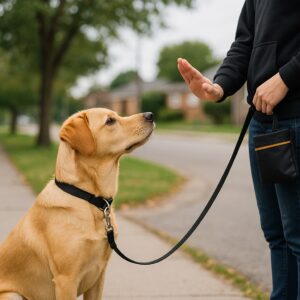
Think of arousal like a volume dial for the nervous system. Low arousal and the dog feels sleepy and slow to respond. High arousal and the dog feels buzzy, jumpy, and likely to chase every moving thing instead of listening. In the middle sits the learning window, a sweet spot where attention is available and choices improve. Movement changes chemistry—dopamine and norepinephrine rise, blood flows faster, oxygen feeds the brain. Moderate exercise takes the dial from dull to engaged without blasting it into chaos. Overly intense bursts immediately before training can flood the system, leaving a dog that grabs at cues or explodes into unwanted behaviours. Too little movement, and the dog checks out. K9 Principles targets the learning window first, and then places skills inside it. For Hamilton families, this means designing short pre-session routines that lift a dog gently into engagement and then settle them enough to think, to ensure your dog training in Hamilton is successful. It is why a five-minute sniffy search followed by a simple warm-up leaves many dogs calmer and more connected than thirty minutes of wild fetch. When the state is right, every rep is cleaner; when the state is wrong, every rep is a fight.
Exercise Types That Accelerate Progress in Hamilton dog training
Movement is not a single tool. Aerobic exercise—steady brisk walking, controlled trotting, structured fetch with clear rules—builds stamina and filters out low-level restlessness. It pairs beautifully with skills that need rhythm, such as loose-lead walking or heel position changes on quieter streets. Short anaerobic play—brief sprints to a toy with a predictable out cue—can spark engagement, but must be sandwiched between calm resets or it flips straight into over-arousal. Proprioception work—slow step-ups on low platforms, careful turns on a pivot, spaced ground poles—builds body awareness and reduces clumsy, explosive movement. It is a secret weapon for dogs that struggle to hold positions because it teaches control through the core rather than pure excitement. Finally, scent work is the nervous system’s pressure valve. Sniffing narrows the world to one sense, slows breathing, and invites methodical problem-solving. Five minutes of hide-and-seek with food or toys can bleed off tension and leave your dogs brain ready to absorb new information. When we design Hamilton dog training plans, we rarely rely on a single exercise mode. We rotate these tools so the brain stays balanced, the body stays healthy, and the learning window opens on cue.
Mental Exercise as a Force Multiplier for Every Cue
Physical work tunes the radio; mental work finds the station. Short shaping games, hand targets, simple position sequences, and pattern games are the multipliers that make each rep count. The goal is not to grind a dog through endless drills. The goal is to create fast, frequent wins that keep the dog engaged and curious. A typical starter block at K9 Principles uses two or three minutes of nosework, a minute of name-and-target, then a handful of repetitions for the day’s focus—perhaps a recall from a short distance or a settle to a mat. Afterwards, decompression returns the dial to calm. This is how dog training becomes sustainable for busy households. There is no need for marathon sessions. There is a need for consistent, purposeful blocks that respect attention spans and build confidence. Families who adopt this rhythm see cues generalise faster, because the dog practises thinking even as environments change. That is crucial for dog training in Hamilton, where waterfront winds, cyclists, and seagulls can easily outbid weak engagement. By pairing movement and brain games, we safeguard focus and keep progress rolling even when the world is noisy.
Personalising Workloads by Age, Breed, and Temperament
Puppies thrive on short, frequent, low-impact bouts that introduce the world gently. Growth plates need protection, so we keep movement varied but moderate and lean heavily on sniffing, exploration, and tiny training intervals. Adolescents pulse with energy and curiosity; structure keeps those surges useful. We set rules for play, add predictable start and stop cues, and use long lines to protect recall while the brain catches up with the body. Adult dogs benefit from balanced blocks of stamina and skill, while seniors flourish with joint-friendly work, slower warm-ups, and enriched sniffing that keeps cognition bright. Breed tendencies guide the recipe. Working and herding lines may look tireless, yet often need more frequent decompression to prevent over-arousal from snowballing. Softer companion breeds might require a stronger aerobic nudge before training to flip engagement on. Temperament does the fine-tuning. Sensitive dogs crave predictable patterns and gentle progressions. Bold, excitable dogs often respond well to a short, structured game followed by deliberate stillness. Through dog training in Hamilton, K9 Principles builds plans that match the dog in front of us rather than a generic template. That customisation removes friction for owners and reduces frustration for dogs, which is exactly what first-time families need.
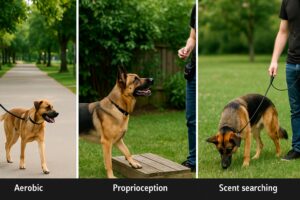
The Ideal Pre-Training Routine: Prime, Train, Cool
Every session gains power when the first ten minutes are right. We start with calm departures from the house. The leash goes on while the dog remains settled. We pause at the threshold so the first step into the world is thoughtful, not explosive. We take a short sniff walk or run a tiny scent game near home, inviting the nervous system to downshift. We then use a simple warm-up sequence that the dog recognises: name, hand target, a couple of position changes, and an orientation game where the dog earns pay for choosing the handler over the environment. Only then do we introduce the day’s focus. Repetitions remain short and precise. Quality outperforms quantity. When the last repetition lands cleanly, we transition into a cool-down: easy loose-lead walking, gentle sniffing, and a mat settle or chew back at home. That pattern works for recall, stay, polite greetings, and loose-lead walking across our dog training programs. It creates habit loops in the dog’s brain—switch on, think, succeed, switch off—so tomorrow’s session starts at a higher baseline. For households starting dog training in Hamilton, this routine is the difference between chaos and clarity.
Common Mistakes That Sabotage Training — And How K9 Principles Fixes Them
The first mistake is chasing exhaustion. Running a dog into the ground with ball throws or chaotic parks does not produce teachable focus. It floods the system with adrenaline and rewards frantic movement. K9 Principles replaces that pattern with measured exercise, structured games, and purposeful cool-downs so arousal rises and then lands. The second mistake is skipping decompression. Ending on a high wires in the very behaviours owners want less of—jumping, spinning, and vocalising. We finish with calm routines so the brain consolidates learning rather than carry turbulence into the next hour. The third mistake is unstructured play. Tug and fetch are excellent tools once rules exist. A clean start cue, a predictable out, and short rounds transform games into skill practice. The fourth mistake is long, unfocused sessions that grind attention down. We favour short bursts because fresh brains learn faster. These adjustments sit at the heart of Hamilton dog training with us, and they are simple enough for first-time owners to apply immediately.
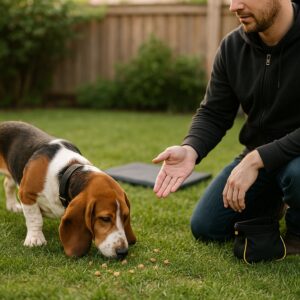
Weekly Blueprints for Real Hamilton Households
Families differ in schedules and energy. The Busy Household blueprint leans on micro-blocks that stack wins. Morning begins with a brief sniff walk to open the learning window, a one-minute warm-up, and a handful of repetitions for the cue of the week. Evening repeats the pattern with a different focus, such as hand targets on the way to the kitchen or a short recall across the lounge, followed by decompression and a chew. The Active Beginner blueprint uses longer but still structured sessions. Alternate days focus on aerobic movement and loose-lead rhythm; the in-between days emphasise scent, proprioception, and short stays that build impulse control. The High-Drive blueprint splits work into two or three mini-sessions, with calming interludes guarding against over-arousal. Ten minutes of controlled cardio, three minutes of pattern games, five minutes of cue practice, then decompression keeps energy useful and thinking intact. These rhythms scale seamlessly around Hamilton’s parks, waterfront paths, and neighbourhood routes, which is precisely why they anchor so much of our dog training in Hamilton planning.
Safety, Surfaces, and Seasons: Smart Adjustments for Consistent Results
Hamilton’s weather shifts quickly, so smart adjustments protect comfort and progress. Warm days invite shorter intense work, shade-hunting routes, and water access where safe. Cold months call for longer warm-ups, careful attention to paws on salted pavements, and more indoor scent and proprioception to prevent cabin fever. Surface matters too. Grass is forgiving but distracting. Smooth paths are predictable but can be slippery in wet conditions. Rubber mats give grip for position practice at home. We encourage owners to mix surfaces so the dog generalises cues beyond a single context. Equipment choices support clarity. A well-fitted harness or a flat collar with a sturdy long line keeps recall rehearsals safe while freedom grows. Treat pouches free up hands and make reinforcement fast. None of this is fancy; it is simply the hardware that makes dog training clean and repeatable. For households navigating Hamilton dog training, these tweaks keep momentum year-round.
Measuring Progress: What Real Improvement Looks Like
Progress is visible long before perfection. A shorter warm-up signals the brain is learning how to switch on. Faster orientation to the handler’s voice means engagement has deepened. Cleaner transitions between movement and stillness show impulse control is maturing. Recovery after surprises—cyclists passing, gulls lifting, a child’s scooter clattering—becomes smoother. Repetitions feel easier and require less prompting. Walks end quietly rather than with post-walk zoomies. Home life changes too: doors open without a lunge, mealtimes run calmly, visitors can step inside without a wrestling match. These markers confirm that exercise and mental work are aligned and that practice is becoming habit. At K9 Principles, this is the standard we set for dog training in Hamilton because it reflects real-world success, not just tidy reps in a quiet room.
Final Word: Train the Brain, Not Just the Body
Balanced exercise is the engine of learning, but regulation is the steering wheel. When movement, sniffing, and short brain games are arranged deliberately, dogs arrive in the learning window quickly and stay there long enough to absorb new information. That is how recall becomes dependable, stays hold steady, and loose-lead walking starts to feel like a relaxed conversation. K9 Principles exists to remove guesswork for families. We build daily rhythms that fit busy lives, teach owners how to set state before skill, and deliver results that hold up in the places Hamilton residents actually use—front yards, local paths, and lively waterfronts. For households beginning their Hamilton dog training journey, and for anyone seeking dependable Hamilton dog training, this approach makes progress predictable and kind.
Contact us for more information:
- Name: K9 Principles
- Address: Haldimand County, Greater Hamilton Area, Burlington, and Most of Norfolk County
- Phone: 289 880-3382
- Email: k9principlesinc@gmail.com
- Website: www.k9principles.ca
FAQs
-
A1. Begin modestly so the dog enters the learning window rather than the red zone. A calm departure from the house, ten to fifteen minutes of steady walking with several sniffing opportunities, a quick warm-up with name and hand targets, and then a handful of precise repetitions will usually produce a noticeably better session. If focus dips, shorten the movement or add more sniffing; if energy feels flat, insert a brief structured game. This balanced approach is the foundation of dog training in Hamilton at K9 Principles and keeps first-time owners on track.



